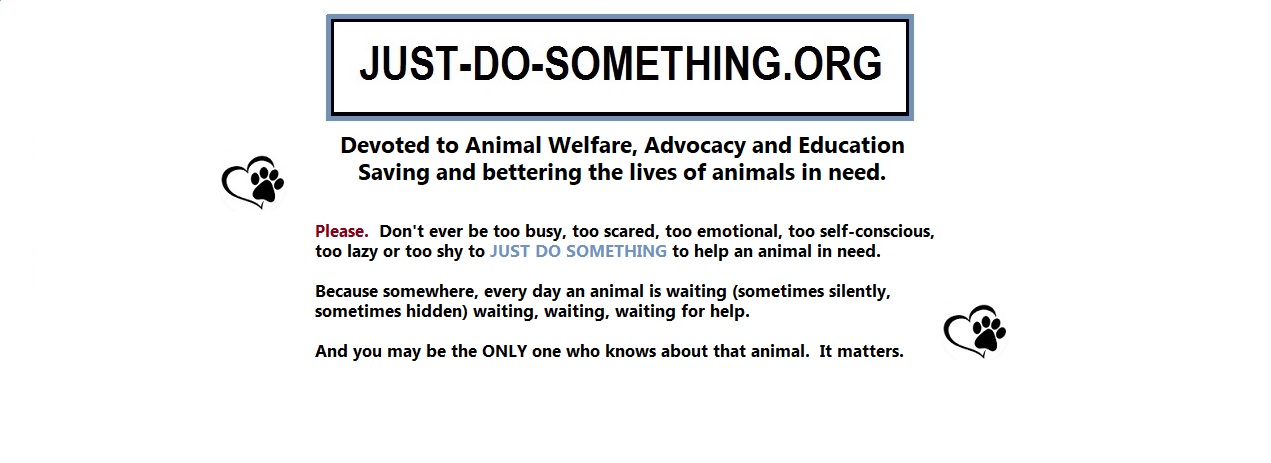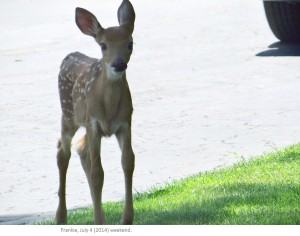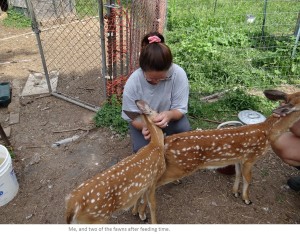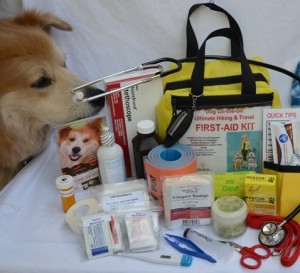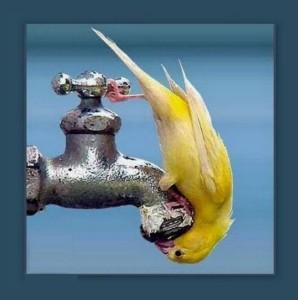Oh, deer!
Before you Comment, take a moment to review our guidelines!
Fawn School 101 started for me the weekend of the July 4th holiday.
Most people celebrate 4th of July weekend in a relaxed state. Cool drink in hand, sneakers kicked off, lounging on the deck to the smell of the grill.
Not so for this July 4th at our house!
It started out with, what we thought, was going to be a quick drive to the store for more ice. As we turned down the street to the main road, there, in the meridian, was a teenie, tiny fawn.
Teenie Tiny Fawn did not realize what a big deal s/he was, hanging out in the middle of a busy intersection, nibbling on fallen leaves from the three ornamental crab apple trees there, seemingly without a care in the world.
Only it WAS a big deal, since s/he had decided to make that small area under the trees THE place to spend afternoons – so close to the busy road (so close), and open enough to entice sneaky coyotes after dusk.
Being such a Momma Bear when it comes to animals, after more than a few drives throughout the afternoon to the meridian to make sure no harm had come to Teenie Tiny Fawn, I wanted to call someone knowledgeable about deer to find out if we should be doing something about our newest spotted neighbor from a safety standpoint (Internet searches were too varied in their information).
I must have left over 25 messages at different numbers that afternoon. But of course, every place we called was closed in observance of the long holiday weekend.
However, never let it be said that there are advocates who don’t work ‘round the clock to ensure the safety of animals! It was the Western New York Wildlife Service who called me back as soon as they received my message (which they checked daily, no matter what the holiday).
What were my main worries? they wanted to know.
- Teenie Tiny Fawn was VERY tiny.
- The meridian was next to a very busy road.
- No matter what time we checked, we did not see Momma.
For the remainder of the weekend, our plan (per the Western New York Wildlife Service) was to make a few trips through the weekend to see if Teenie Tiny Fawn was still hanging out in the same spot, to note what time(s) s/he appeared, and to see if we could spot (from the car) Momma. Many times, Momma will leave her fawn(s) alone for many hours per day. But at least once every few days, if you look around, you will spot her around the area since they are never far from their young. Usually, a fawn that is abandoned will begin bleating for its Momma after a few hours, and will continue to bleat until it becomes too tired or too dehydrated.
I was to report back on Monday.
Monday arrived and nothing had changed. Teenie Tiny Fawn continued to hang out, alone, in the hot sun, for hours in the same spot.
Western New York Wildlife Service asked for pictures so they could estimate the condition, weight and age of Teenie Tiny Fawn, which was now nicknamed Frankie.
- It was determined that Frankie was healthy but underweight.
- There was no way to know if Frankie was abandoned or if Momma had been hit by a car. Although I did talk with our town’s Dead Animal Collection representative who stated that at the time we spotted Frankie, he was not notified of any dead deer that needed to be picked up – so that was good news.
- Although Frankie seemed to be nibbling on leaves on the ground, he was still too young to properly forage for him/herself.
- Although Frankie was mobile and alert, he was at risk of dehydration because there was not a reliable water source nearby.
- Although Frankie was able to run, he was too small to properly defend himself against harm (ie, coyotes).
- Frankie was very close to a very busy road.
There were discussions of capture, but usually unless the fawn is injured or in distress, this is used as a last option. Capturing ANY animal will cause it severe anxiety, sometimes to the point of death. And since Frankie seemed okay, and in the event Momma was around, this was not a reasonable solution.
Our new game plan was put in place:
- Put up two large signs at each end of the meridian, letting traffic know there was a baby deer in the area.
- Buy a bag of Calf Manna and place some in a bowl (along with a tub of water) under of the trees that Frankie was hanging around. **Note that it is illegal to feed wild deer in a domestic setting. In order to do this, you need specific permission from a DEC Representative and you should notify your local Animal Control.
- Check the area every day for Momma.
Happily, once the water was put out, Frankie found and enjoyed it. Relief that we didn’t have to worry about dehydration!
During this time, I was also put in touch with a member of the Western New York Wildlife Service who takes in abandoned fawns on her animal farm (which is DEC certified). Virginia T. sees to their shelter and nutritional needs until they are old enough to be taken to a deer sanctuary.
After a few weeks, Frankie had vacated the meridian. I’d like to think that s/he put on a little more weight, and found Momma or a companion herd. We continue to see deer and fawn in our neighborhood, and it’d be nice to know that Frankie is one of them.
Virginia and I have remained in touch, and more recently, I made the trip to Virginia’s animal farm. Virginia was waiting, with baby bottles of deer formula. I got to feed my first fawn – who looked just like Frankie.
And, I kept the Baby Deer signs – just in case.
Do you have a baby animal story? We’d love to hear it.
Note: Have you come across a baby animal? NEVER approach a baby animal unless you can see immediate injury or danger. Call Animal Control immediately if you have concerns or questions. Since our local Animal Control was closed when we first spotted Frankie, I searched the Internet to see who else I could contact with my immediate questions.
